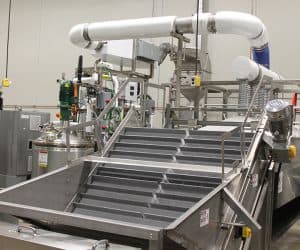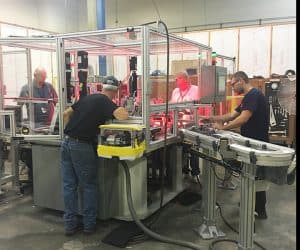Machine Design and Build
Check out our Machine Design and Build Portfolio
Optimation’s applied experience in machine design and build ranges from providing single-part design expertise to full turnkey solutions. Our engineers and designers work comfortably in a wide variety of industries, including chemical, film, glass, automotive, food and beverage, energy, and aerospace industries. We have delivered machines that coat, dry, and finish web-based products, assemble hard goods, or provide support functions like material handling and packaging. Need design support? Optimation can provide technical personnel who will work at your site, providing inside engineering and design services as needed.
Machine Design Applications
- Conceptual Design/Prototype Development
- Design for Manufacturability
- Design for Reuse/Machine Repurposing
- Design for Material and Wear Optimization
- Product Design
- Metric and Imperial Design/Drafting
- Tolerancing (geometric)
- Actuation Design/Sensing
- Fastening/Joining/Assembly
- Automated Assembly Machine Engineering
Computer Aided Design Tools for Machine Design/Drafting

- Autocad 2D
- Autocad 3D
- Solidworks
- Unigraphics
Prototyping for Machine Design-to-Build
Save time during your prototype phase by using Optimation’s design-to-build services. We have the capability to upload CAD files from our designer’s workstation to selected CNC machines, eliminating the need for time consuming manual machine set ups.
Turnkey Machine Design and Build Services
One of the advantages of offering a Turnkey Machine model to our clients is the efficiencies garnered on the part of the client in working with one service provider throughout the life of the project. Optimation provides all the resources needed (engineering, custom machine design and build, installation, system controls and integration, ongoing maintenance and troubleshooting support) to provide your system and keep it running effectively throughout its useful life.
Turnkey Project Work Process
Optimation’s project team collaborates with their clients to deliver a turnkey solution using a method rightfully labeled “Phases and Gates” (or sometimes called Front End Loading (FEL)). This approach to executing a complex project of many inter-related activities breaks the work flow down into smaller, more manageable segments (called phases) that are usually architected around logical decision points in the project life (called gates). For example:
- Project inception might be called a “Strategic Phase” during which a problem statement or opportunity is derived. A proposed, high level solution is suggested, and a first pass implementation cost, schedule, and business case are developed. Once this data is gathered, the decision makers hold a “gate” and either stop the project, recast its objective, or approve its proceeding.
- A Requirements phase would follow, that would utilize the output of the Strategic Phase to develop more details around the project goals and objectives. During this phase, a broader range of needs are considered and documented, including
- Operability and maintainability
- Reliability, yield, line performance
- Safety
- Product design interactions
- Standard components
- Information Systems and Controls, data flow
The gate for the completion of the Requirements phase would be a client sign off on the document.
- Conceptual Design Phase, which might include
- Technology assessment
- Preferred approach selection
- Concept model of preferred approach
- Layout
- Equipment list
- Controls system architecture
- Operating Description
- Factored cost and schedule estimates
- Risks, assumptions and exclusions
- Updated Business Case calculation
The gate for the Concept Design phase would be a design review and approval of the design, and a decision on whether or not to stop the project, recast its scope, or continue by funding the Preliminary Engineering phase.
Other follow on phases might be Preliminary Engineering, which develops the Concept Design to the extent that equipment details are derived and a fixed price can be estimated; Detailed Design, which completes the fabrication drawings and launches project execution, Purchase and Fabrication, when components and sub-assemblies are procured and built; Assembly, where complete machine modules are assembled mechanically and electrically; FAT or Factory Acceptance Test; Installation (at client site); Debug and Start Up; and Commissioning.
Interested in working together?
“You are easy to work with, right from the first call to job completion. I wish all of my vendors and suppliers were as easy to work with.”
